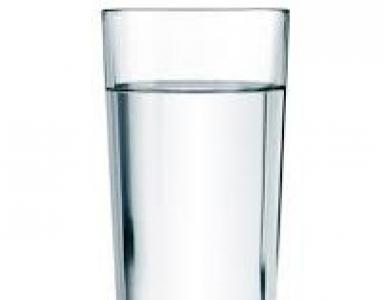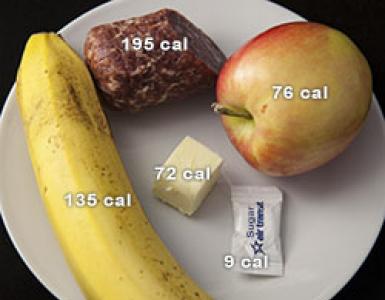Flour confectionery. Classification and characteristics of flour confectionery
Classification and characteristics of flour confectionery
On the basis of data on the chemical composition of products and the norms for the consumption of food products, a range of products is determined, which in each individual case can provide for the body's need for food substances.
In GOST R 53041-2008 "Confectionery and semi-finished confectionery products. Terms and Definitions "defines a" confectionery product "as a confectionery product that is a baked food product or an article containing in its composition a baked convenience product based on flour and sugar with a flour content of at least 25% in the baked convenience product. /
To flour confectionery products include: cookies, wafers, gingerbread, cake, roll, cake, cake, flour eastern product.
Flour confectionery products can be fully or partially coated with chocolate, glaze or unglazed, with filling, without stuffing, interlaced with finishing semi-finished products, with surface finish.
Cookies are a flour confectionery product of various forms with a mass fraction of moisture not exceeding 15.5%. /4/
To the liver carry:
1. sugar cookies - biscuits of flat shape, brittle, loose structure, with filling, without filling, glazed, unglazed, with a mass fraction of total sugar not exceeding 27%, mass fraction of fat from 2% to 30%, mass fraction of moisture not more than 10 %. In the assortment: Orange, Lemon, Strawberry, For tea - from flour of the highest grade; Sugar, Chess, Road, Our brand - from the first grade flour; News, Carrot - from second-class flour. / 12 /
2. Lingering cookies are cookies of a varied flat shape, layered structure, with piercing, glazed, unglazed, with a mass fraction of total sugar not more than 20% (4), a mass fraction of fat from 3%. (Child, School, Maria - from flour of the highest grade; Sports, Croquet; Mixture No. 2 - from the first grade flour; Ukrainian, Nov, Mixture No. 1 - from second grade flour) / 12 /;
3. biscuits - biscuits of a variety of flat or three-dimensional shape with filling, without a filling, glazed, unglazed, with the sum of the mass fractions of sugar and (or) fat, and (or) egg products, and (or) milk and its products - not less than 30%, with a mass fraction of moisture - not more than 15.5%, a mass fraction of total sugar - not less than 12%, a mass fraction of fat - not less than 2.3%. Prepared from the highest grade flour, it has small sizes, it can be of various shapes, with a filling, sometimes glazed in chocolate. It is subdivided into short-cut, short-sand, croutons, almond-nut;
4. Interlaced cookies - two or more cookies, interlaced with finishing semi-finished products, glazed or unglazed. For example: ChocoPie;
5. cracker cookies layered structure with oily surface, with a mass fraction of total sugar not more than 10%, mass fraction of fat - not less than 10%, mass fraction of moisture - not more than 7%. According to the recipe and method of preparation, the cracker is divided into three types: with fat or with fat and fat, with fat or fat and fat layer with the addition of flavoring substances (cumin, anise, cheese), without fat;
6. The biscuit is a layered biscuit with through punctures, with the sum of mass fractions of sugar and (or) fat not more than 29%, the mass fraction of moisture is not more than 11%. The biscuits produce simple, improved (with the addition of fat), dietary (with sugar and fat) / 12 /.
Wafers are a flour confectionery product made of waffle sheets interlaid with or without fillings, with a mass fraction of moisture not exceeding 8.4%. For wafers with fruit filling, the mass fraction of moisture is no more than 15.3%. The wafer is made in the form of round, rectangular, triangular, in the form of sticks, tubules, curly. For interlayer waffle sheets used fondant, praline, fat, fruit fillings. Assortment: Artek, Chocolate, Creamy, For tea.
Gingerbread is a variety of confectionery with a convex top surface, with or without spices, honey, with or without pattern, with or without filling, glazed or unglazed, with a mass fraction of total sugar of at least 24%, mass fraction moisture - no more than 20%. / 4 / By the way of preparation subdivide into raw and custard. To the group of gingerbreads include rugs (baked semi-finished gingerbread with fruit filling). Gingerbread cookies have a darker color, more fragrant and do not stale longer. Gingerbreads are produced in various shapes, with or without filling, glazed with chocolate, fat glaze, sugar syrup, sprinkled with sugar / 12 /.
Cupcake is a bulk confectionery product with large and (or) small additions or without them, with or without filling, with or without surface finish, with a mass fraction of total sugar of not less than 20%, a mass fraction of fat of not less than 10% mass fraction of moisture not more than 30%. In the dough for cakes add raisins, nuts, poppy seeds, candied fruits, cinnamon, saffron, ginger. The surface of the cupcakes after baking is decorated with sugar powder, nuts, and glazed with lipstick. A large number of varieties of cupcakes with various fillings, cream and fruit are produced.
Sorts of cupcakes:
1. cupcake "Metropolitan" - rectangular shape with a lot of raisins;
2. "Curd" cake - with the addition of cottage cheese;
3. cupcake "Spring" - a round form of yeast dough, decorated with powdered sugar and nuts;
4. "Russian" cake from yeast dough, sprinkled with nuts;
5. cupcake "Moskovsky" - with raisins, glazed with fondant / 12 /.
New varieties of cupcakes are characterized by a slow process of hardening.
Roll: a flour confectionery product made from a rolled baked semi-finished product and finishing semi-finished product (s), with or without surface finish. The main assortment of rolls, depending on the use of fruit jam: apricot, strawberry, raspberry, cherry, blackcurrant, forest berry, boiled condensed milk, blackberry, chocolate and blueberry. These rolls are packed in a colorful label, which is made of metallized polypropylene.
Biscuit rolls of the "Lux" class have a mass of 200 g and are decorated with chocolate glaze and are interlaced with delicious cream filling, with the taste of coconut, walnut, rum, they can be of the following types: nut, cappuccino, cream, almond-coconut, chocolate-cream, pistachio or rum.
Biscuit mini-rolls have a mass of up to 35g, glazed with chocolate glaze and wrapped individually in a variety of colorful labels that are packed into decorated art boxes of 16 units, with a total weight of up to 560g, or packed in a 5-pack, total weight up to 175 grams, which are wrapped in a label.
Cupcake is a bulk confectionery product with large and (or) small additions or without them, with or without filling, with or without surface finish, with a mass fraction of total sugar of at least 20%, a mass fraction of fat of not less than 10% mass fraction of moisture not more than 30%. They are often cooked on chemical baking powder: Moscow, Almond, Citrus. Cupcakes can be prepared from a yeast dough: Home, Russian, Spring.
A cake is a complex, multicomponent confectionery product, having a varied shape, with a surface design consisting of two or more different semi-finished products: baked and finishes, with a mass of not less than 150 gr. The basis of the cakes are baked convenience foods: sand, biscuit, puff, custard, nut, protein-churned (air), crumbly, waffle, combined. The basic finishing materials: lipsticks, syrups, fruit and berry fillings, jellies, candied fruits, nuts, chocolate, creams, marshmallows. Range:
biscuit cakes: Othello, Autumn, Fairy Tale, Sponge cake, Truffle, Coffee, Vanilla, Gift; protein-whipped cakes: Flight, Day and night and many others.
Cake complex, multi-component confectionery product, having a variety of shapes, with a surface design, consisting of two or more different semi-finished products: baked and dressing, weighing not more than 150 g. Cake can be: sand - rings, baskets; biscuit; layered tubes; bows; custard - Eclairs, Coveted rings, Nutlet; crockery - Potato covering, Potato glazed, Amateur cake; almond-nut; protein-chopped - Fungus, Lotus, Aerial, Beze.
The floury eastern product is a flour confectionery product made with the peculiarities of the recipes of the national Oriental cuisine, consisting of flour, sugar, fat, nuts, dried fruits, spices and other raw materials. To the eastern flour product include: biscuit with cinnamon, earth, chicken, roll with a nut, a tube with a nut, shaker-lukum, shaker-churek, nan, strudel, baklava and others.
In this issue, the classification and characteristics of flour confectionery products are examined and conclusions are drawn that a flour confectionery product is a product containing in its composition a baked semi-finished product based on flour and sugar with a flour content of at least 25% in the baked semi-finished product. The classification is defined in GOST R 53041-2008 "Confectionery and semi-finished confectionery products. Terms and definitions »: cookies, biscuits, gingerbread, cakes, rolls, cakes, pastries. Flour confectionery products have a wide range.
Full text search:
Home\u003e Abstract\u003e Culture and Art
1 Analytical review of literature
Classification of flour confectionery products
Confectionery products are food products of industrial production, for the production of which about 200 kinds of various raw materials are used. One of them is sugar. Basically, these are sweet products, characterized by a pleasant sweet taste, complex aroma, beautiful appearance and high nutritional value.
Confectionery products are divided into two groups: sugary and flour. Saccharides include fruit and berry products, caramel, dragées, chocolate, cocoa powder, sweets, iris, halva and oriental sweets. For pastry, confectionery products include cookies, gingerbread, waffles, muffins, rum baba, rolls, eastern flour sweets, cakes, cakes.
Flour confectionery mainly contains a large amount of sugar, fat and eggs. They are characterized by high nutritional value, pleasant taste and attractive appearance. To flour confectionery products include cookies, crackers, gingerbread confectionery products, wafers, muffins, cakes and pastries, biscuits, rolls, Belarusian rolls, rum babu.
Cookies - the most common type of flour confectionery products with a high content of sugar and fat, low moisture content, a variety of forms. Cookies are divided into sugar, long, sweet (sand-jigging, sand-vyemnoe, type of crackers, nut, slaughter).
Cracker (dry biscuit) is a flour confectionery product with a high fat content, a layered and brittle structure, the surface is smooth with punctures. The taste is due to the lack of sugar in the recipe or a small portion of it, as well as the inclusion of spices and flavor additives (onion, sesame seed, garlic, dill, poppy, etc.) into the formulation.
The biscuits are pastry confectionery of long-term storage, replacing bread in travels, expeditions, at home. In appearance, they are similar to lingering cookies, but they have a large thickness.
Sweets - confectionery, which is made from flour with the addition of sugar, fat, nuts, dried, canned and fresh fruits, spices and other raw materials.
Wafers are products that are highly porous sheets with or without filling.
Cakes and pastries are products of various shapes and sizes, with an attractive appearance, characterized by high caloric content, produced from flour, sugar, eggs, nuts, chocolate and other raw materials.
Cakes are piece products of various shapes and small masses with decorative trim. Cakes differ from cakes with a larger size and a sophisticated finish.
Cupcakes are high-calorie confectionery products, baked from dough, with a variety of exterior finishes.
Rolls are folded layers of biscuit dough, interlaced with different fillings.
Baba Baba is a smooth yeast soft product in the form of a truncated cone, with a ribbed or smooth surface impregnated with syrup (with the addition of rum flavor) and tinted with sugar fondant.
Spice-cakes are national Russian confectionery products of various shapes, soft consistency. It is a food product baked from wheat flour, fat, sugar, on chemical baking powder with the addition of various spices. The name "gingerbread" comes from the word "spice", as a mandatory additive in the gingerbread test is "dry perfume" - a mixture of ground cinnamon, cloves, cardamom, nutmeg, badyan, sweet pepper and black, ginger, vanillin.
In the Republic of Belarus, gingerbread products are GOST 15810-96. Gingerbread products are made in accordance with the requirements of this standard for recipes and technological instructions, with observance of the existing sanitary norms and rules approved in the established order.
Depending on the way of preparation, gingerbread products are divided into:
custard - with the brewing of flour;
raw - without brewing flour.
Depending on the content of the filling, gingerbread products are divided into:
gingerbread without stuffing;
gingerbread with filling;
ginger with or without filling.
Depending on the type of surface, gingerbread products are divided into:
glazed;
uncoated.
The thickness of gingerbread products should be not less than:
18 mm - for gingerbread without filling;
14 mm - for gingerbreads such as Baby, Vyazemsky, Tula, figured and cooked on artificial honey with rye flour;
20 mm - for gingerbread type cakes;
30 mm for carpets in each layer.
Gingerbread are piece (printed) and weight.
Piece gingerbreads are, as a rule, products with a filling inside with a pattern printed on the surface, packed in cardboard or other colorfully decorated boxes. Weight gingerbread can be of classical size, and also skillful.
Gingerbread can be with open stuffing from dried apricots, bananas, prunes, and also closed - from jam, jam, jam, etc..
Gingerbread products belong to flour confectionery, which are characterized by a high content of sugar, eggs, fat. Gingerbread and gingerbread belong to gingerbread products. A distinctive feature of gingerbread from other flour confectionery products is the use of "dry spirits" in their recipe.
1.2 Chemical composition and nutritional value of gingerbread products
The nutritional value of any food product can be assessed by the conformity of the content of the most important components of food products (proteins, fats, carbohydrates, minerals, vitamins) to the balanced nutrition formula. The law of balanced nutrition determines the proportions of individual substances in diets.
Proteins are the most valuable and indispensable components of food. White substances are high-molecular colloids. Under the influence of enzymes in the human body, proteins break down into amino acids and the products of their decay. Of these, amino acids, proteins and substances of protein nature necessary for the body are being synthesized again. Some amino acids in the body are not synthesized, and therefore must come with food. These are the so-called non-substitutable amino acids. There are eight of them: isoleucine, leucine, lysine, methionine, phenylalanine, tryptophan, threonine, valine. Also, two are allocated for children: origine and histidine.
Ideally, there should be a certain content of each essential amino acid.
Protein of food raw materials, used in the production of confectionery products, has a different value. The most valuable proteins are proteins of milk, eggs. Plant proteins are deficient in individual amino acids. So, the protein of wheat contains about 50% of lysine, the protein of legumes - about 60% of methionine and cystine.
The biological value of proteins depends not so much on their amino acid composition as on the availability of the enzyme of the gastrointestinal tract and the degree of digestibility. The digestibility of food proteins is different. Proteins of milk and eggs are absorbed on average by 96%, bread from flour of 1st and 2nd grades - by 85%, bobo - by 70%. Proteins should average 12% of the caloric value of the daily diet and be combined with other food substances in certain ratios.
With protein deficiency observed slowing growth, mental development, disruption of hematopoiesis, bone formation, reduced resistance to infections. Excess of the protein leads to joint disease, urolithiasis, gout.
When developing new types of products, creating combined products, it is necessary to use proteins of vegetable and dairy raw materials. Many flour confectionery products combine dairy products, egg products, wheat flour, etc.
In the technological processes during the heat treatment of raw materials, the quality and digestibility of the protein change. With mild treatment regimes, protein uptake increases. Long-term heat treatment of raw materials under severe conditions leads to a reduction in the price of protein.
Belkiemuchnyh confectionery products undergo changes mainly in baking.
The intensity of these changes depends on the temperature and the duration of the treatment and is manifested primarily in the change in color.
Fats (lipids) are included in food in animal fats (butter, milk and cream margarines), as well as dairy and egg products and vegetable oils (sub-solar, corn, soy, rapeseed, olive).
The great importance of fats is explained by their participation in the formation of cellular structures, especially membranes, and the performance of various functions. In addition, fats are a source of vitamins and other biologically active substances. Fats are the only source of fat-soluble vitamins A and D. At the same time, fats have high energy value and increase the calorie content of foods.
Fats consist of triglycerides and lipoid substances (phospholipids, sterols, etc.). The composition of triglycerides includes glycerin and various fatty acids (saturated, unsaturated).
Saturated fatty acids in the largest amount are contained in animal fats and cause their solid state and high melting point. Saturated fatty acids - palmitic, stearic, myristic, etc. Consumption of animal fats leads to an increase in the level of cholesterol in the blood, the development of atherosclerosis, obesity, cholelithiasis.
Unsaturated fatty acids are contained in a larger amount in plant fats, which are a source of vitamins E and beta-carotene. They can be monounsaturated, ie, contain one unsaturated hydrogen bond, or poly-unsaturated, having several such bonds. The main fatty acid with one unsaturated bond is oleic acid. In the largest amount it is contained in olive oil - 65%, in butter - 23%.
Polyunsaturated fatty acids (PUFA) include linoleic, linolenic and arachidonic acids. Of these, an essential acid is linoleic.
It is not synthesized in the body and must come with food. The main source of linoleic acid is sunflower oil - 60%.
Unsaturated fatty acids in the human body play a significant role, preventing the deposition of cholesterol in walls of blood vessels and, thus, the formation of atherosclerotic plaques. PUFAs play the role of plastic material in the biosynthesis of cell membranes. In the daily diet, the nutritional value of PUFA should be 4-6% of its energy value.
The optimum ratio between the sums of saturated, monounsaturated and polyunsaturated fatty acids is 3: 6: 1.
Carbohydrates in many food products constitute a significant part, especially in confectionery products. Carbohydrates are represented by simple sugars and polysaccharides.
TO simple carbohydrates relate monosaccharides (glucose, fruit-toza , xylose, arabinose), disaccharides (sucrose, maltose, lacto- ), trisaccharides (raffinose, tetrasaccharide, stachyose).
To polysaccharide, hemicelluloses, starch, insulin , glycogen , cellulose, pectin substances, gums, dextrans .
Assimilability of carbohydrates is different. Do not digest substances in the group "Coarse" dietary fiber (cellulose and etc.) and Soft dietary fiber (pectin substances, gums, dextrans, etc.). Assimilated carbohydrates have an energy value and cover 50-60% total number of calories. The daily need of an adult in assimilated carbohydrates is 365-400 in the diets should be 20-25 g of food grade locust , at including 10-15 g fiber and pectin.
From Sakharov glucose, which is introduced with food or is formed from carbohydrates (sucrose, starch), is most effectively absorbed quickly.
Starch is contained in a considerable quantity in flour confectionery products. In general, in the diet starch composes about 80% of the total amount of carbohydrates consumed.
Fiber helps to remove cholesterol from the body. Excess cellulose adversely affects the body, reducing the digestibility of nutrients by 5-15%, binds vitamins and minerals.
Pectinates a positive role in poisoning with toxic metals, in suppressing the development of putrefactive microorganisms.
Organic acids (lemon, apple, etc.) are actively involved in the metabolism, have an energy value.
Confectionery, sweet products, differing pleasant taste and aroma by all of us are loved since the childhood. We sometimes call them - sweets, sweets. As the main raw material for cooking, as a rule, is used flour (wheat, rarely corn, rice, oatmeal, etc.), sugar, honey, fruits, berries, milk, cream, fats, eggs, yeast, starch, cocoa, nuts, food acids, gelling agents, flavors, food colorings and disintegrants. The legendary cook and historian V. V. Pokhlebkin believed that in all types of confectionery test flour takes a subordinate position (the exception is a dough for cakes and gingerbread), and also there is no water.
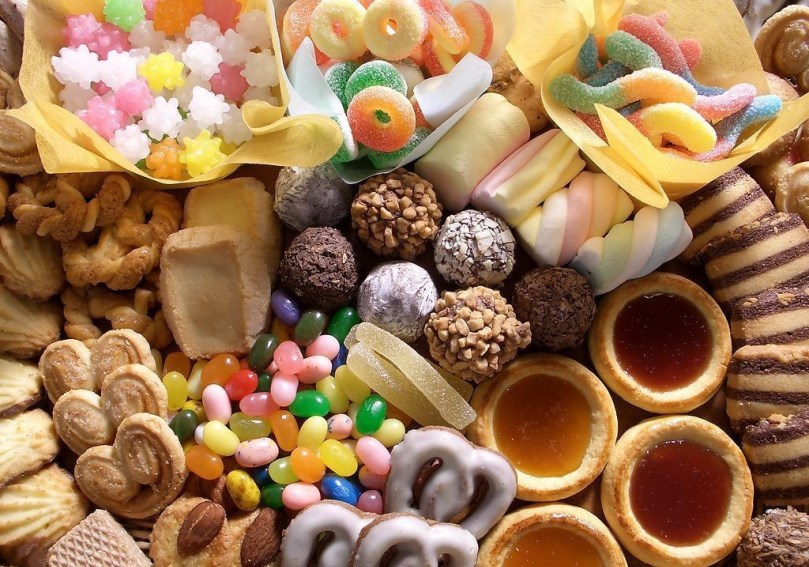
Depending on the ingredients used, all types of confectionery products fall into two main groups: sugary and floury. And, although often the confectionery product contains elements of both groups, it is considered, however, that only one is basic (for example, wafers with strawberries are flour, although strawberry filler is saccharic).
Sugary confectionery
Beze, Merengi
This French dessert consists of whipped with sugar and baked egg whites. Sometimes also used are tartar or corn starch (as a binding component). Often meringues are seasoned with vanilla and a small amount of coconut or almond extract. These products are light and airy (like a Latin American dance meringue) and very sweet (fr. baiser - "kiss").
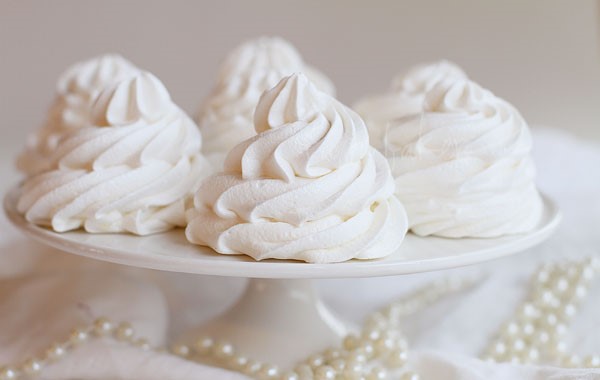
Merengi
Jam, jam, jam, marmalade, confiture, eats
These are fruit or berries brewed in sweet syrup, flower petals, are classified according to the technology of preparation and the consistency of the finished product. So, unlike jams, jam, confiture and marmalade, jam is prepared in such a way that the ingredients retain their shape. In addition, the jam has a non-uniform consistency and consists of more or less liquid syrup and individual pieces of fruit, or even small fruits (figs, paradise apples) and berries entirely.
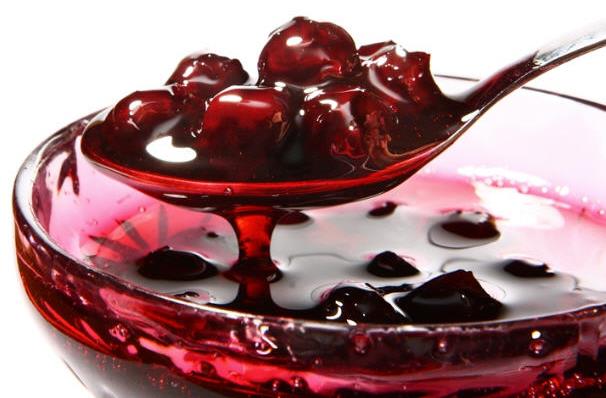
Jam
Jam - sweet dense mass of wiped fruits or berries, cooked with sugar or molasses. Jam is prepared exactly like jam, but unlike it, the syrup in the finished product must be jelly-like. Conferences - a kind of jam, jelly with whole or crushed fruits or berries. This word was given to us by the French: confiture, from confit - candied. Marmalade - a culinary product made from fruits, cooked with sugar, with the addition of a thickener and flavorings (can be considered a variety of thick jam). As a thickener, substances such as pectin, agar-agar, gelatin are used. In English-speaking countries the word marmalade means only jam from citrus (especially from oranges).
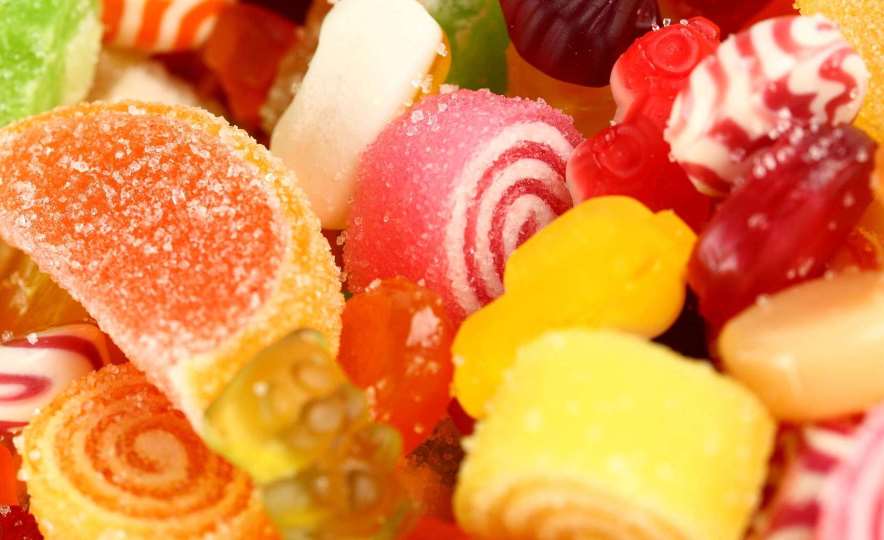
Marmalade
Yot is a kind of Korean traditional sweets. There are both solid and liquid (molasses), as well as with fillings. They are prepared from steam rice, glutinous rice, glutinous sorghum, corn, sweet potato or a mixture of these grains. After boiling for a couple of eats, they do not ferment for long, and then they are boiled for a long time in a large cauldron. If eats are brewed longer, it hardens upon cooling. Immediately after cooking, it usually has a brown color, but if it is stretched, the color becomes lighter.
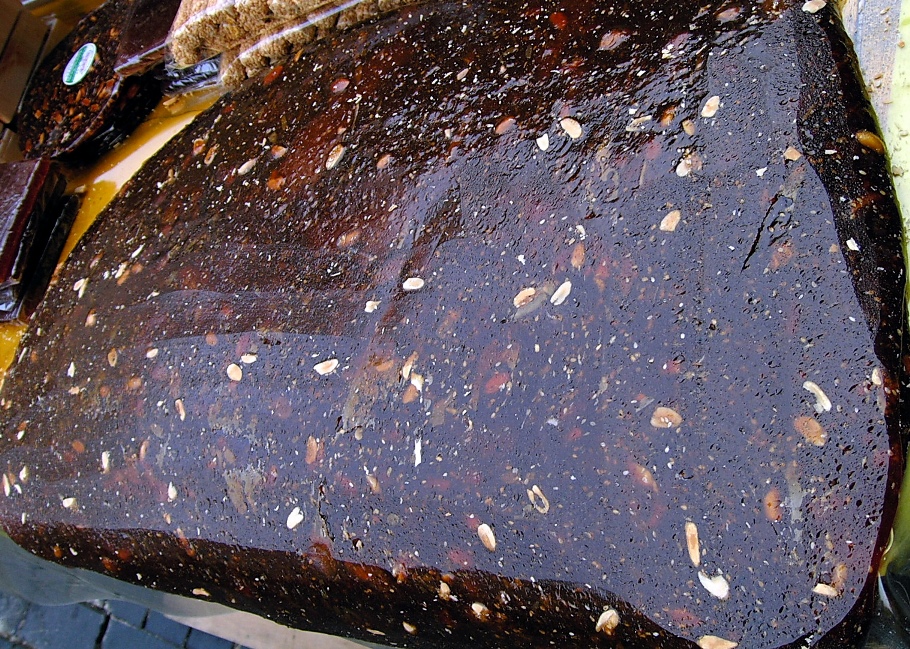
Ginger eats
Grilyazh
Grilyazh (Fr. grillage "Frying") - French dessert of fried nuts with sugar. Occurs from the eastern halva of coarse grinding. Confectioners are divided into two types of grilling: soft grilling - includes the salted fruits and crushed nuts; solid grilling - is a crushed nuts, filled with molten sugar.
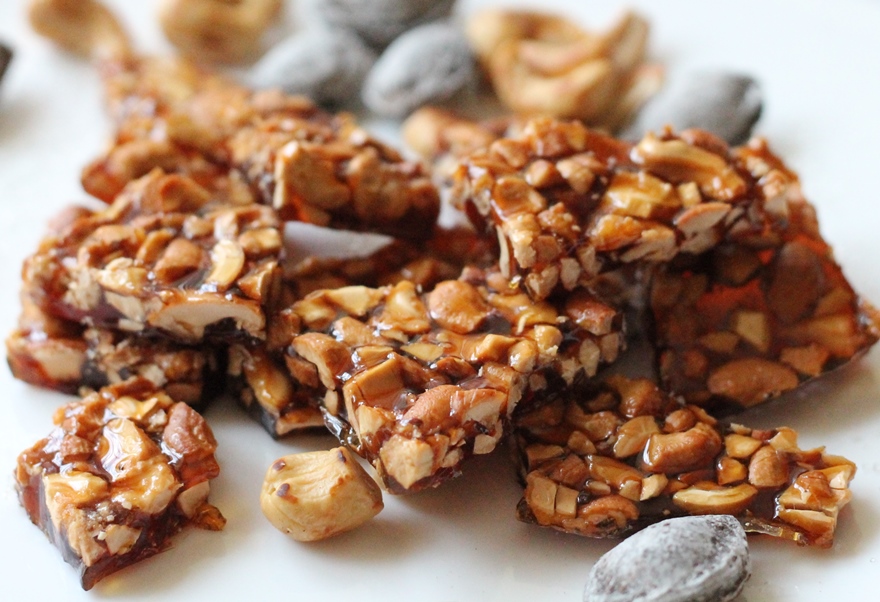
Soft grilling
Jelly
Jelly (from Fr. Geée - jelly, gel, jelly) - food colloidal solution (usually based on fruit), which is added with gelatin (pectin, agar), and when cooling the whole mass gets a gelatinous appearance. Fruit jelly from fruits and fruits containing a lot of pectin, you can get and without adding gelatin to them, as pectin itself gives the gelatinous syrup. Most often this jelly is made from sour, mostly Anthony's apples, and then it is stained with spinach in green and carmine - in red.
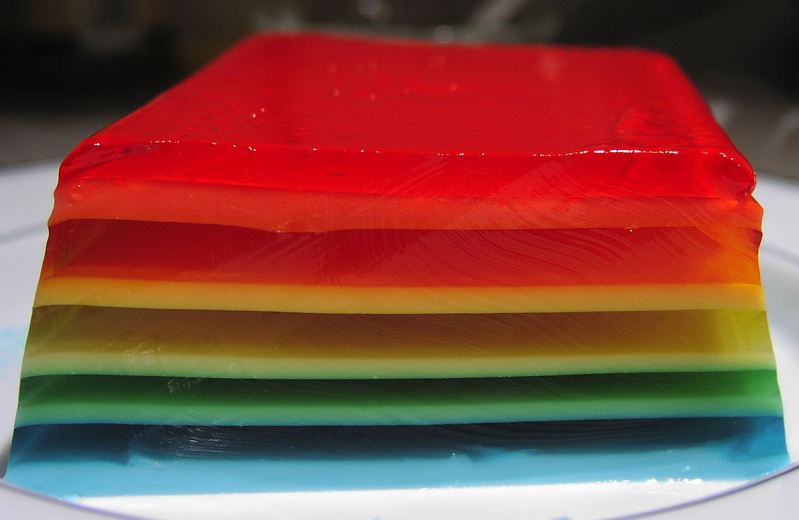
Puff pastry
Marshmallow, pastille
Zephyr - a kind of sugar confectionery; is obtained by knocking down the fruit and berry puree with sugar and egg whites, followed by the addition of any of the formulating (gelatinous) fillers: pectin, agar syrup, gelatinous (marmalade) mass. Zephyr was prepared in ancient Greece, where it received its name after the god Zephyr, according to the myths that gave his recipe to people.
Paste (from French. pastille) - a sweet dish of Russian cuisine. Until the beginning of the twentieth century, the word often wrote "postil" (understanding it as something postlannoe, spread out, which is associated with the technology of making pastilles). Pastilles were made from whipped apples, sour Russian varieties (antonovka, titovka, zelenka), as well as pulp of berries (cowberry, mountain ash, raspberry, currant). The second important component of the pastille is honey, and since the XIX century also sugar. The third (optional) component of the pastille, used from the 15th century, is the egg white, which was needed to make the pastille white. Traditionally, the pastille was made in a Russian oven: it gives the effect of gradually decreasing heat, which ensures a uniform drying of the paste from apple puree, honey, sugar and protein, applied thinly on the fabric on wooden frames. Several layers of the past past the original paste are layered on top of each other, after which they pass a secondary drying in wooden crates of alder in the oven.

Zephyr

Paste
Candy, iris, caramel, lollipops
Small sweets in the form of balls, tiles, cushions of caramelized sugar, chocolate, molasses, condensed milk and other products. Iris - fondant mass obtained by boiling condensed milk with sugar, molasses (molasses) and fat (cream or vegetable oil or margarine). In crushed form is sold as candy. Caramel (Fr. caramel, from the late Late. cannamella - "sugarcane") - a confectionery product or ingredient of such a product obtained by heating sugar or by boiling a sugar solution with starch syrup or invert syrup. It is a plastic or solid mass (depending on the heating temperature) of various shades of yellow and brown color (without additional staining), contains sucrose, maltose and glucose. Lollipop - a kind of sweets, a viscous or solid mass made from candis - brewed to hardness, usually flavored sugar with molasses or corn syrup. Often fixed on a stick.

Crushed Iris
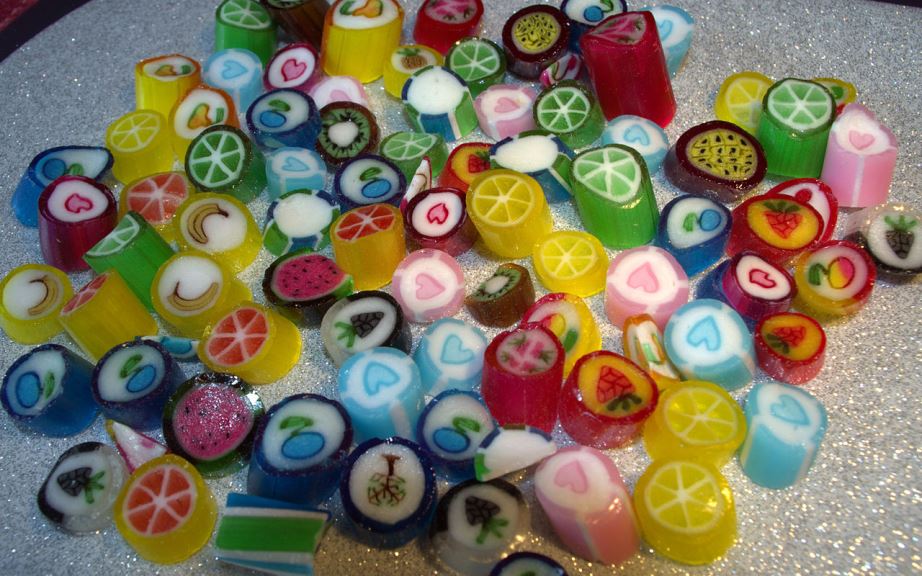
Lollipops

Lollipops
Creams
Cream - Pasta from cream or butter with sugar, used as a filling and for decorating cakes and pastries. Instead of butter, margarine can be used, and as additional ingredients - eggs, milk, as well as various flavoring and flavoring additives: cocoa powder, vanilla, etc.
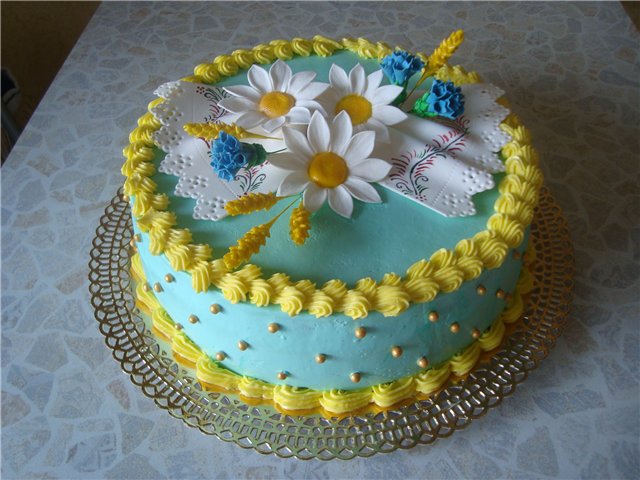
Cake decorated with cream
Marzipan
Marzipan (German. Marzipan, Italy. marzapane) - a mixture of ground almonds and sugar syrup (or powdered sugar). If apricots are used instead of almonds (less often peaches), the confectionery product is called not marzipan, but persipanum. Sometimes marzipan is also called a mass of other nuts, as well as products with it. For example, in Russia buns are distributed - "marzipans" with peanuts.

Fruit from marzipan
Moussa
Mousse(Fr. mousse "Foam") - a sweet dessert dish. A specialty of French cuisine. It is prepared from an aromatic base (fruit or berry juice, mashed potatoes, grape wine, chocolate, coffee, cocoa, etc.), food substances that promote the formation and fixation of a foamy state of mousse (egg proteins, gelatin, agar), as well as food substances that impart dish sweet taste or enhancing it (sugar, saccharin, honey, treacle). Sometimes, instead of egg whites and gelatin, a semolina substitute is used, which is able to swell well and has gluing properties, which allows for approximately simulating the necessary state of the dish.

Chocolate mousse
Sweet
Fondant paste (fondant) - a sweetened sugary-flavored syrup, quickly cooled to a temperature of 35-40 ° and stirred at a high speed in a pomade-blasting machine. When knocked down in a supersaturated syrup, crystallization of sucrose occurs. The finished product consists of small sugar crystals and intercrystalline syrup. Fondant mass varies greatly in consistence - from liquid, viscous species with a high content of molasses to a hard brittle product, which is obtained from a less moist syrup with a small amount of molasses. Used mainly for the production of unglazed sweets and for decorating cakes.
Depending on the presence of milk, there are three main types of fondant: sugar pomade - from sugar-free syrup without adding milk; lipstick dairy or creamy - on the basis of a sugarparate syrup with a small or medium addition of milk or cream; creme brulee - a sugar-flavored syrup with a high content of milk or cream after the passage of heat treatment, which gives the product a brown tinge and a taste of melted milk.

Cake glazed with sugar lipstick
Sambuc
Chilled air dish, prepared by whipping fruit mashed potatoes with sugar and egg whites.

Sambuca of black currant
Souffle
Souffle (Fr. Souffé) - a dish of French origin from egg yolks, mixed with a variety of ingredients, to which are added whipped white egg whites. It can be a main course or a sweet dessert. In any case, the souffle contains at least two components: first, a flavored mixture of sour cream consistency and, secondly, white whipped egg whites. The first gives a taste, and whipped proteins - the airiness of the product. The mixture is usually made on the basis of cottage cheese, chocolate or lemon (the last two cook the dessert, adding sugar). The soufflé is cooked in an oven in a fire-resistant bowl, it swells with temperature, but, taken out of the oven, falls off after 20-30 minutes.

Chocolate soufflé with powdered sugar
Halva, lukum and other oriental sweets
All kinds of biscuits, raisins, nuts and starch and sugar products, common in the Middle East and Central Asia.
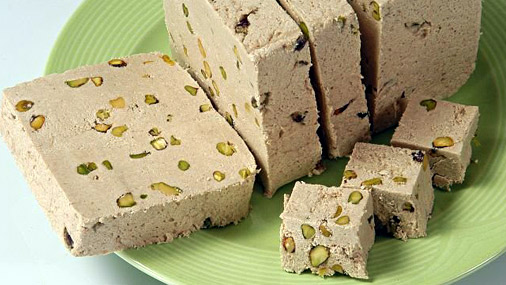
Halva

A typical example of fruit rahat-lukuma (pomegranate)
Candied fruit
Candied fruit (Polish. cukaty, from cukier - "sugar") - juicy fruits cooked in sugar or sugarparate syrup. Candied fruit is used as a filling in biscuit, cake, sweet, short, yeast dough and as a separate decor element for decorating cakes, pastries, cookies, rolls, slices. For desserts it is used as a filling and decor at the same time. From citrus peel, candied fruits are cooked slowly in a syrup until a clear, glassy flesh and high sugar content are obtained. Cooked crusts are thrown back on a sieve, separated from syrup, allowed to drain, and then dried.
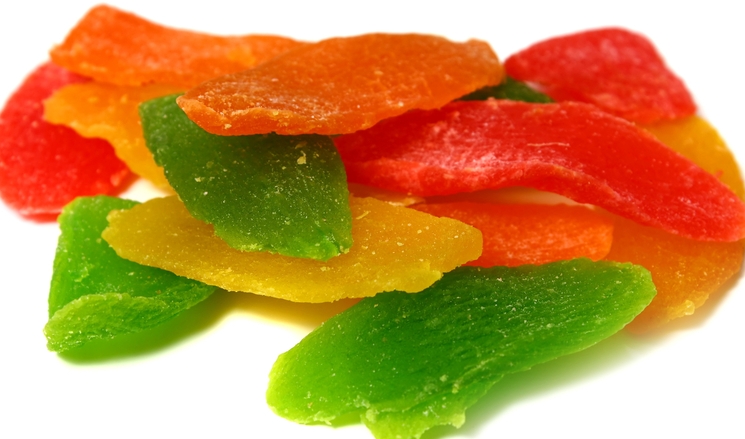
Candied fruit
Chocolate
Chocolate - a confectionery product based on cocoa butter, which is a product of processing cocoa beans - chocolate tree seeds, rich in theobromine and caffeine. Chocolate products often contain aromatic additives (coffee, alcohol, cognac, vanillin, pepper), food additives (raisins, nuts, waffles, candied fruits) or stuffing.

Chocolate bars
Flour confectionery
Cake
Cake (from Italy. torta, "Round bread") - a dessert consisting of one or several cakes impregnated with cream or jam. Top of the cake is usually decorated with cream, glaze and / or fruit.
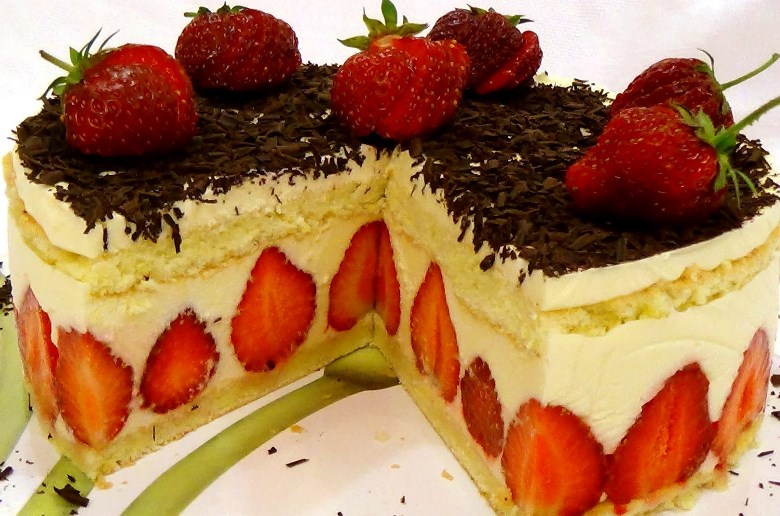
Cake "Fraisier" (Fraisier)
Biscuit
Biscuit - a small confectionery product baked from dough. To the pastry test, various grains are sometimes added; cookies are usually formed in the form of circles, squares, asterisks, tubes; sometimes cookies are made with a filling (chocolate, raisins, condensed milk, cream) or put a filling between two cookies.
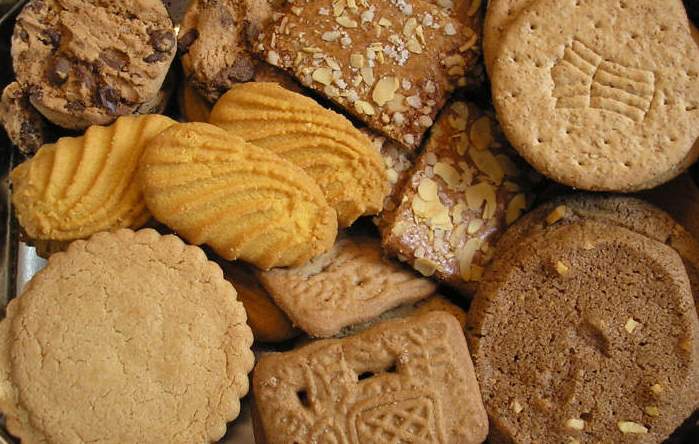
Wafers
Wafer (from it. Waffel) - a kind of thin dry biscuit with an impression on the surface. Baked from whipped liquid dough in special forms. The dough consists of flour, eggs, sugar and cream. The name wafers was derived from the Middle German term "wâfel". The Danish form "wafel" in the XVIII century changed into a waffle and entered into the Russian language in this form. Pieces of waffles are often lubricated with cream. Ice cream or berries can be used. For the layer used fat, fruit and berry, praline, fondant and other fillings. Can be used as a basis for other confectionery products (cakes, pastries). For these purposes, waffle products are produced in the form of sheets, cakes, cups, tubes, horns.
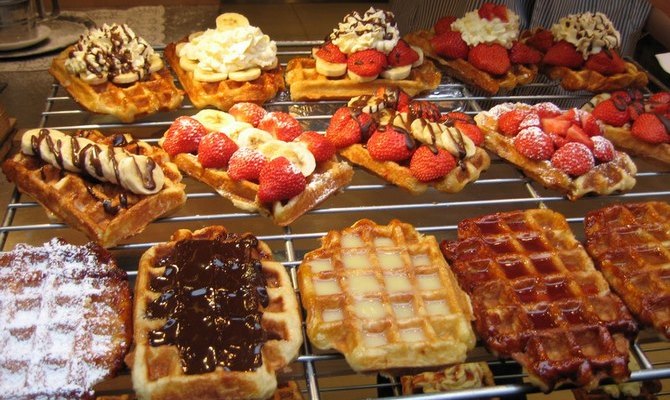
Belgian waffles
Sweet cakes, patties, cheesecakes, rolls, donuts, muffins, rum
Bakery products from yeast, puff, fresh baked, brewed and other dough of various shapes and sizes, with or without filling, baked or fried. Pie - a dish of dough with a filling that is baked or roasted. The filling for pies can be different - berries, fruit, cottage cheese, poppy, etc. Pie - a small dish of yeast dough stuffed, which is baked (in the oven) or roasted (in fryers, small pots or boilers). The name is formed from the word pie. Cheesecake - round, open from above and protected only from the edges of a flat cake with filler. Typically, as a filler used cottage cheese, less often mashed potatoes, jam or jam. An item of Old Slavic, Russian and Ukrainian cuisine. The name of the dish comes from the word "vatra" - "hearth, fire". Cheesecakes are baked from yeast, dough and unleavened dough. Donut - round, fried in oil, usually sweet, a patty with a hole in the middle or without it. The hole is designed so that the donut extracted from the hot oil is strung on the rod, from which the product is then put in a bag or on a plate by the buyer. In a donut, there may be a filling: jam, jam, jam, etc. Cake - a sweet confectionery product with raisins, jam or nuts, usually baked from a yeast or sponge cake and traditionally served for weddings or Christmas. Cupcakes can be baked in a rectangular shape or round (with a through hole in the center, which will give it the shape of a large ring). The closest relative of the cake is Russian cake. Baba - a confectionery item of Slavic origin, is a kind of cake made from a yeast dough with the addition of raisins. After baking, it is soaked in syrup from rum or other alcoholic beverage and sugar, or simply sugar syrup, sometimes with the addition of jam. The top part of the cupcake is smeared with sugar fondant. It is often called "rum-baba".
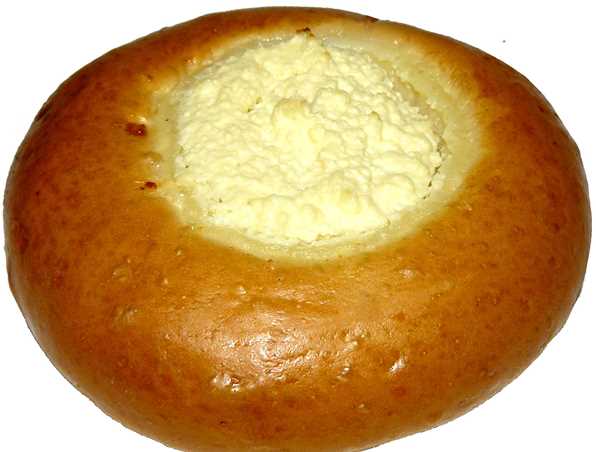
Cheesecake with cottage cheese
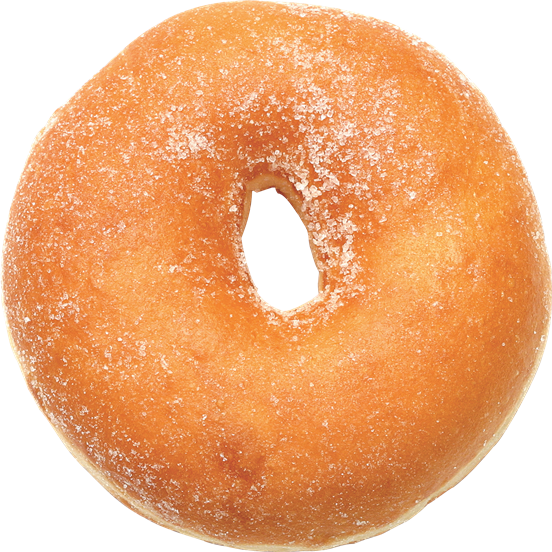
Donut
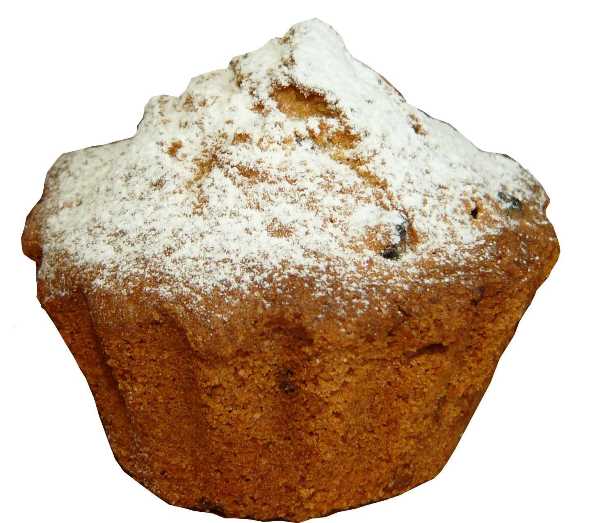
Cake
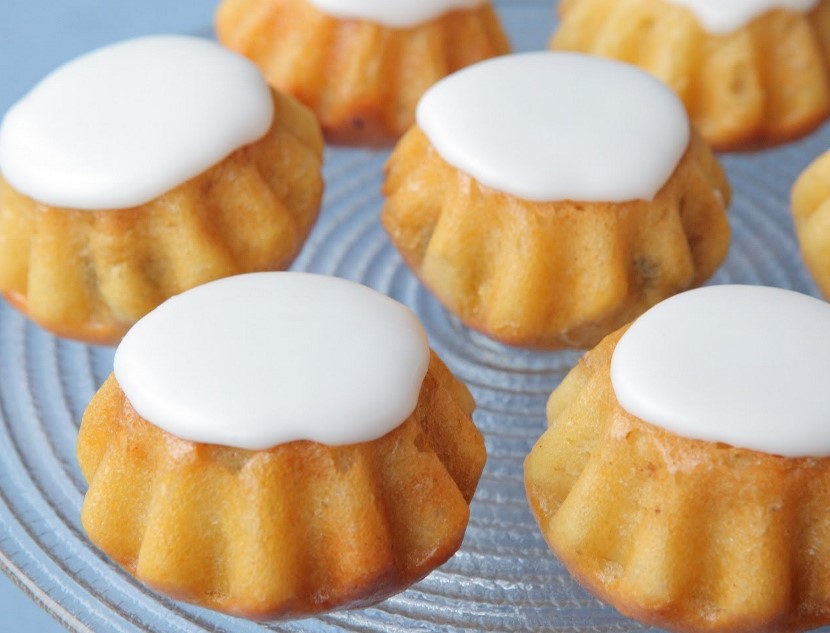
Baba
Gingerbread, gingerbread
Gingerbread - flour confectionery product, baked from a special gingerbread dough; for taste can be added honey, nuts, candied fruits, raisins, fruit or berry jam. In appearance, a gingerbread is most often a slightly convex plate in the middle of a rectangular, round or oval shape, usually an inscription or an uncomplicated figure is usually printed on top, often a layer of sugar confectionery is applied on top. The gingerbread comes from the adjective spicy (dr.russian "piñrjany"), which, in turn, is formed from the word "pepper" (dr.-Russian "piьr"), which denotes spices and condiments.
Carpet - a gingerbread dough from a very small size to 1-1.5 meters in length, up to 1 meter in width, and a height of 6-10 centimeters. Weight gingerbread sometimes reaches a pood or more. A popular dish of Russian cuisine. The word "carpet" comes from "carpet", which means whole-grain bread. The history of gingerbread and cakes in Russia begins with the 9th century, only then they were called honey cakes and were made from flour, honey and berry juice.
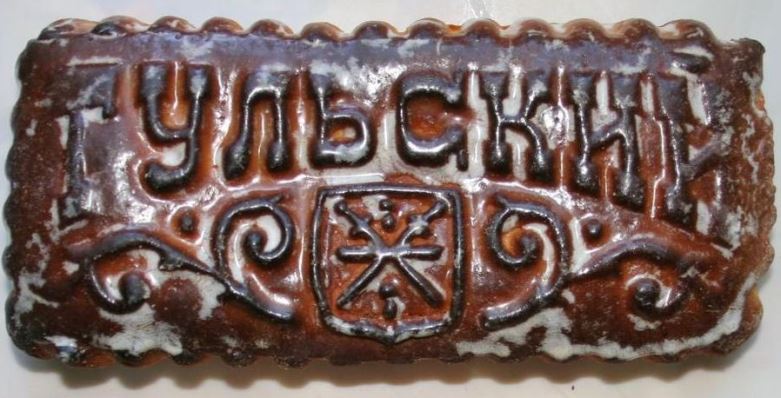
Tula Printed Gingerbread

Carpet
Cakes, eclairs
Cake - a small confectionery product made of sweet dough, usually with a cream filling. Eclair (from Fr. éclair - "lightning, flash") - French dessert in the form of an oblong patty pie from a custard batter with cream (usually brewed). The creation of an eclair is attributed to the French culinary expert Marie-Antoine Caramou. It became widespread in the XIX century.

Cake

Eclairs in chocolate and sugar glaze
Confectionery and bakery products are food products with a characteristic sweet, pleasant taste and aroma. They have an attractive appearance, are characterized by high caloric content and easy digestibility. A confectionery product is an integral part in the nutrition of many people.
Composition
The production of confectionery products is carried out using different raw materials. They, in particular, are sugar or a sugar substitute, honey, butter, milk, molasses, various berries and fruits. Preparation of complex flour confectionery products is also carried out using starch, flour, cocoa products. Nuts, edible oils, fats (margarine and others) are also used. In addition, in the production of confectionery products are used:
- Various These include tartrazine, turmeric, carmine.
- Frothers. Among them, blood albumin, egg whites are popular.
- Preservatives. These include sulphurous, benzoic,
- Flavors: vanillin, various essences, essential oils.
- Food acids: wine, apple, lemon.
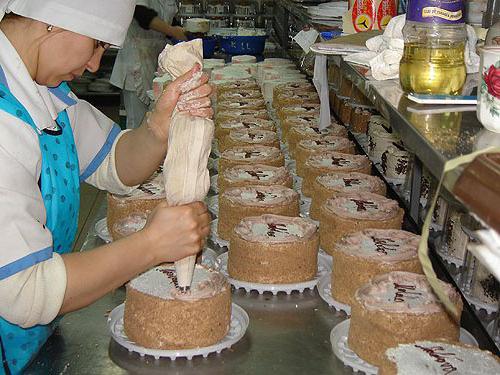
Classification
A confectionery product can refer to one of two existing groups. In particular, produce sugary products. This group includes chocolate, caramel, fruit and berry products, dragees, iris, halva, sweets. They also produce flour confectionery. These include cookies, waffles, gingerbread, cakes and cakes, rum women, muffins, rolls and stuff.
Description
A confectionery product is a food product with a high carbohydrate content. They, in particular, are sugar and starch. Confectionery can be used for dessert both independently and with various drinks. For example, they are taken for food with coffee, tea, juice, some wines. A distinctive feature of all confectionery products is a pleasant, usually sweet taste. The degree of sweetness can vary depending on the type of product and the manufacturer's recipe. The confectionery has a beautiful appearance and a mouth-watering fragrance.
Characteristic in appearance
One of the main indicators of the quality of confectionery products is their appearance. It is this feature that is evaluated first of all for all products of this category. However, as practice shows, it is not the most reliable, since the fabric of a counterfeit fabric often has a similarity to its original counterpart. Confectionery products differ in color. This is explained by the variety of colorants of the raw materials used in the process of manufacturing the goods. Some of them can change their shade during heat treatment. Also, quite often the technology of confectionery products involves the addition of dyes of natural or artificial origin. For example, they include caramelines or melanoidins. Most often the natural coloring due to the pigment of the raw material is manifested in the production of flour confectionery, iris, halva, some kinds of sweets (for example, milk). Some products from flour can be additionally painted with the help of auxiliary raw materials - saffron, eggs, etc. They are characterized by a golden, yellow and brown shade. Glazed confectionery products may also differ in color. Their color depends on the color of the glaze used. Manufacture of confectionery products with a brown coating is carried out using chocolate syrup, with light (white, pink, etc.) - with the use of a special glaze. With assortment identification, the color of the coating must be determined separately from the color of the main product. 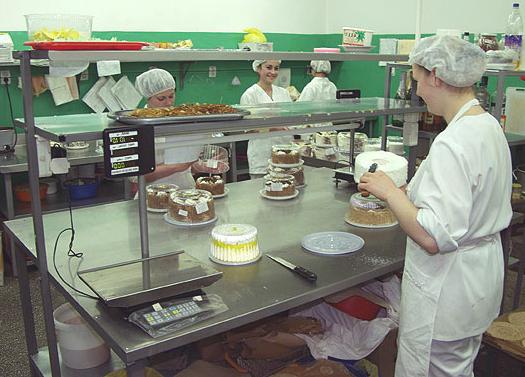
Characteristic form
The most important indicator used in conducting the species identification of the assortment is the form. Even within a single group of confectionery products, this parameter can be significantly different. As a rule, this indicator is determined at the manufacturing stage. In this case, all subsequent phases, which include the technology of making confectionery, and the stages of commodity advancement, can not affect the finished product form. Among the wide variety of species and subgroups of the products under consideration, there are 5 main forms:
- Round. It is typical for some types of cakes, biscuits. Such forms are cookies, pills, sweets, cakes and marshmallows.
- Oval. It is used for making cakes, marmalade, gingerbread and cookies.
- Rectangular. Danae form is characteristic mainly for pastille, chocolate, jellied cut and stripe marmalade, cookies, wafers, rolls and cakes, cakes and pastries.
- Square. This form is used for biscuits, iris, marmalade, biscuits, cakes.
- Figured. It can be used for making marmalade, chocolate, candy, caramel, gingerbread, etc.
When carrying out brand and assortment identification, the quality of the external coating of the product is also taken into account.
Characteristic by smell
The main indicators of the qualimetric identification of the product are its smell and taste. In the event that any kind of discrepancy is detected on the basis of these characteristics or if flavors and flavors are not present in the product, the gradation of product quality is reduced. However, despite the fact that the preparation of confectionery is often carried out using raw materials with different aromatic and flavoring properties, some products of one type may lack a characteristic flavor and, moreover, a smell. But, as a rule, the products have a sweet taste. It is thanks to him that goods of this type are very popular among children and women. Flour confectionery products are characterized by a moderate and slightly expressed sweet taste (crackers, biscuits). In contrast, the sugary products have a brighter, rich flavor. 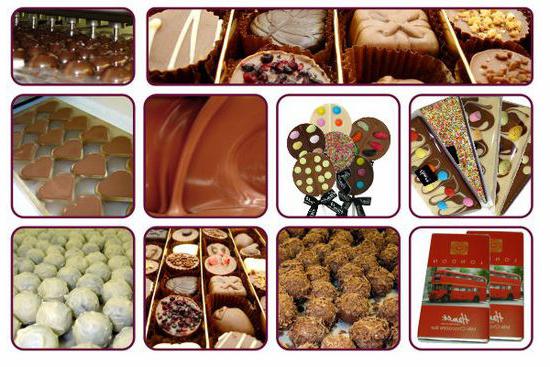 Qualitative identification also involves the definition of odor. However, there is no single flavor for all products combined into a common subgroup. In sugary confectionery products, honey and fruit-berry, less often mint flavor are predominantly found. This factor is due to the smell of the raw material (or its imitation) used to make the product. Often, the choice of flavor is determined by the name of the product, for example, the cherry "Cherry" or "Apple in cream". As a rule, food synthetic flavors are used to give the product the desired odor. This is due to the fact that natural substances in the heat treatment have the property of escaping. In order to make up for their loss, smells of artificial origin identical to natural ones are introduced into the product. The aroma of flour confectionery products is formed at the time of baking. At the same time, it is used not fermented, but loosened by chemical means. In this regard, the characteristic "bread smell" inherent in bakery products, they do not. To make the baking characteristic of her sweetish, spicy flavor, baking and spices are used. In this case, each type of product corresponds to its specific odor. For example, the juicy aroma of gingerbread (obtained as a result of using spices), cake or cookies can not be confused with anything. However, the preparation of flour confectionery products is often carried out using flavors. This allows you to simulate any smell.
Qualitative identification also involves the definition of odor. However, there is no single flavor for all products combined into a common subgroup. In sugary confectionery products, honey and fruit-berry, less often mint flavor are predominantly found. This factor is due to the smell of the raw material (or its imitation) used to make the product. Often, the choice of flavor is determined by the name of the product, for example, the cherry "Cherry" or "Apple in cream". As a rule, food synthetic flavors are used to give the product the desired odor. This is due to the fact that natural substances in the heat treatment have the property of escaping. In order to make up for their loss, smells of artificial origin identical to natural ones are introduced into the product. The aroma of flour confectionery products is formed at the time of baking. At the same time, it is used not fermented, but loosened by chemical means. In this regard, the characteristic "bread smell" inherent in bakery products, they do not. To make the baking characteristic of her sweetish, spicy flavor, baking and spices are used. In this case, each type of product corresponds to its specific odor. For example, the juicy aroma of gingerbread (obtained as a result of using spices), cake or cookies can not be confused with anything. However, the preparation of flour confectionery products is often carried out using flavors. This allows you to simulate any smell.
Products from yeast dough
Depending on the amount of baking in the recipe of the product, they distinguish the spicy and safe method of preparing the dough in confectionery production. If the amount of sugar and oil in the composition is small, then all products are kneaded simultaneously. This method of cooking is called "free". High concentration of muffin suppresses the activity of yeast cells, that is, the conditions for fermentation become unfavorable. It proceeds very slowly, gluten is formed of poor quality. In order for the fermentation process to proceed normally, it is first necessary to mix the liquid consistency dough. To do this, mix water, flour, yeast and a small amount of sugar. The resulting mixture is called opaque, and the method of preparation is sparse. Then you need to wait for the dough to ferment, then add the baking to it. Then add the rest of the flour. The less muffin is present in the test, the more water there should be and the less yeast. 
Recipe for buns "Homemade"
Required:
- Flour - 6755
- Sugar sand - 1420
- Margarine - 1485
- Melange - 190 g.
- Salt - 60 g.
- Yeast - 170 g.
- Water - 2850 g.
On the output you will get 100 rolls of 100 g each.
Cooking process:
- From the test, made by the odor method, it is necessary to roll small balls on 107 g each.
- Then put them on a baking tray in a special way. It is necessary that the distance between them is not less than 8-10 cm.
- After this, the pan should be placed in a warm damp place with a proofing.
- Approximately 5-10 minutes before baking balls of dough should be smeared with eggs with a special brush and sprinkle them with sugar.
- After this, the pan can be placed in a preheated oven to 230 ° C and bake for 10 minutes.
Result:
Buns of round shape, their color can range from a pleasant golden to light brown hue. The surface of the products is shiny, the dough is well roasted. 
Cheesecake Recipe
Required:
- Flour - 3800 g.
- Margarine - 200 g.
- Melange - 200 g.
- Salt - 40 g.
- Yeast - 100 g.
- Water - 1500 g.
- Filling (jam or cottage cheese) - 3000 g.
- Oil (grease the pan) - 25 g.
- Melange (grease the cheesecake) -150 g.
The output will be 100 cheesecakes, 75 g each.
Cooking process:
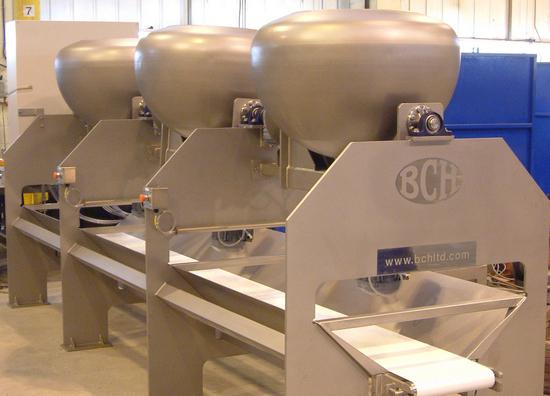
The recipe for making mussel cake
Required:
- Flour Extra Class - 5070 g.
- Sugar sand - 1445
- Margarine - 1000 g.
- Melange - 900 g.
- Raisins - 830 g.
- Salt - 15 g.
- Yeast - 205 g.
- Vanillin - 35 g.
- Water - 1460
- Margarine (for lubricating forms) - 115 g.
- Melange - 115 g.
- Sugar powder (for sprinkling) - 100 g.
The total mass of cakes at the outlet is 10 kg.
Cooking process:
- Knead the yeast dough with the odor method.
- Cylindrical molds for cupcakes should be smeared with melted margarine and spread out a prepared mass in them.
- Then the molds with the dough should be left for 20-25 minutes for proofing at a temperature of 30 ° C.
- After that, the surface of the cupcakes should be greased with egg.
- To ensure that no voids are formed under the crust, the dough should be pierced in several places at a depth of 2-3 cm. The products are ready for baking.
- After cooling, the side and top side of the cupcakes should be sprinkled with powdered sugar.
Baking of this type can be either piece or weight.
Special menu
To comply with dietary and rational eating habits, the products of reduced caloric content are most suitable. In this case, when making confectionery products, sugar, flour and fat is recommended to be replaced with less energy-intensive and easily digestible ingredients. For example, the filling for baking can be from low-fat cottage cheese, a wiped mass of boiled vegetables, fruit puree or pasta.
Flour confectionery products are food products, for the preparation of which along with sugar flour is used.
The group of confectionery products include:
- cookies, crackers and biscuits;
- Gingerbread;
- cakes and pastries;
- cupcakes, rum women, rolls.
All kinds of flour confectionery products are characterized by high food and energy value. Low humidity of these products allows you to store them for a long time.
Manufacture of flour confectionery products consists of the following operations: dough preparation, molding, baking, cooling, packaging.
To loosen the dough in the production of flour confectionery products, yeast is used only for some products, and mainly - chemical baking powder (baking soda, ammonium carbonate).
Chemical disintegrants under the influence of high temperature decompose with the release of gaseous products.
Cookies are made from the highest grade flour, wheat, as well as oatmeal, sugar, milk, culinary and melted fats, eggs, salt, aromatic substances, organic acids and chemical disintegrants.
Cookies are subdivided depending on the recipes and production features on the species: sugar, long, sweet.
Sugar Cookies Is a common type of flour confectionery. It is prepared from plastic dough with weak and medium gluten, sugar content 20-30%, fat - not less than 9.5%. Sugar biscuits are characterized by fragility, porosity, swelling, there is a pattern on the front surface. It is a well-preserved food concentrate.
Range:
- Orange, Lemon, Strawberry, For tea - from flour of the highest grade;
- Sugar, Chess, Road, Our brand - from the first grade flour;
- News, Carrot - from flour of the second grade.
Long-lasting cookies prepared from elastic-elastic dough; sugar content up to 20%, fat content up to 8%. The biscuit slowly swells in water, is lighter in color, has a pronounced layered structure (after kneading it is subjected to repeated rolling with aging); on its surface there are punctures.
Assortment: Baby, School, Maria - from flour of the highest grade; Sports, Croquet, Mixture No. 2 - from the first grade flour; Ukrainian, Nov, Mixture # 1 - from flour of the 2nd grade.
Butter Cookies, or dessert, has a large content of rich additives - fats, sugar, eggs, flavoring substances.
It is made from the highest grade flour, it has small sizes, it can be of various shapes, with a filling, sometimes glazed with chocolate.
Biscuit cookies are divided into shortbread cookies, sand-cake, protein-sloughing, crackers, almond-nut.
Cookies are cut out manually from the rolled sheet of dough with the help of tin cans.
Cookies are jigged - set on a test-press machine and squeezed out dough through so-called mouthpieces.
Protein-slaughtered cookies are prepared by knocking down egg whites with sugar powder and kneading this mass with flour and other additives.
Almond-nut cookies are obtained from ground nuts (often almonds), sugar, egg whites with flour, etc.
Cracker (dry biscuits) is produced from wheat flour of the highest and 1st grade without sugar with added fat, has a layered, brittle structure and punctures on the surface. The cracker is prepared on yeast, or on yeast and chemical baking powder, or on certain chemical baking powder.
According to the recipe and method of preparation, the cracker is divided into three types:
1. With fat or fat and fat.
2. With fat or fat and fat layer with addition
gustatory substances (cumin, anise, cheese).
3. Without fat.
Biscuits - flour confectionery products dry, rectangular or square, with punctures on the surface without the addition of sugar and fat (or with a minimum number of them). This product is a long-term storage, it can be used instead of bread. The biscuits produce simple, improved (with the addition of fat) and dietary (with sugar and fat).
The quality of cookies, crackers, biscuits is judged by taste and smell, color, surface condition; the figure is clear, the finish should be in accordance with the recipe.
The standard normalizes the physicochemical parameters: the moisture content of the biscuit, the mass fraction of sugar, fat, etc.
Inadmissible defects of cookies, crackers, biscuits: extraneous smells, flavors, inclusions, impurities, mold, contamination of products, contamination with granary pests.
Storage. Cookies, crackers, biscuits are stored at a temperature of 18 ° C and relative humidity of 65-75%.
Guaranteed storage time:
- for sugar and long cookies - 3 months;
- for buttery cookies with a mass fraction of fat of 10% - up to, 45 days;
- for crackers with a mass fraction of fat not more than 14.3% - 3 months;
- for biscuits simple, hermetically packed - 2 years;
- for the improved packaged - 6 months.
Gingerbread - a flour confectionery products mainly round in shape with a convex surface, soft consistency, usually a spicy sweet taste, contain sugar up to 45% with or without fat.
By the way the gingerbread cookies are subdivided into raw and custard. To the group of gingerbreads include rugs (baked semi-finished gingerbread with fruit filling).
Raw gingerbread is kneaded without brewing flour on a cold sugar or sugar-treacle syrup.
The custard cakes are produced in three stages: first brew the flour with a hot sugar-treacle or honey syrup, cool the tea leaves, mix the tea leaves with the rest of the raw materials.
Gingerbread cookies have a darker color, more fragrant and do not stale longer. Gingerbreads are produced in various shapes, with or without filling, glazed with chocolate, fat glaze, sugar syrup, sugar-coated, etc.
Quality requirement
The quality of gingerbread is judged by the state of the surface, shape, color, appearance at the break, taste, smell.
For each denomination the sugar content, fat content, alkalinity, gingerbread thickness and other parameters are normalized.
Inadmissible defects of gingerbread are deformation, burnt, sticky crack surface, cavities, impurities, the presence of voids, foreign flavors and odors.
Store at a temperature of 18 ° C and a relative humidity of 75%.
Shelf life of raw gingerbread from 10 to 30 days, brewed - from 30 to 45 days.
Flour confectionery products differ from sugary ones in that their formulation includes flour. These products are highly caloric and digestible, they have a pleasant taste and attractive appearance. The high nutritional value of flour confectionery products is due to a significant content of carbohydrates, fats, proteins. Due to low humidity, most products are a valuable food product with a long shelf life.
Depending on the recipe and the method of production, they are divided into groups: biscuits, crackers (dry biscuits) and biscuits; gingerbread; waffles; cakes and cakes; muffins, rolls and rum; flour eastern sweets.
Production of all types of pastry includes operations such as dough preparation, molding, baking, cooling, packaging, for some types - finishing.


